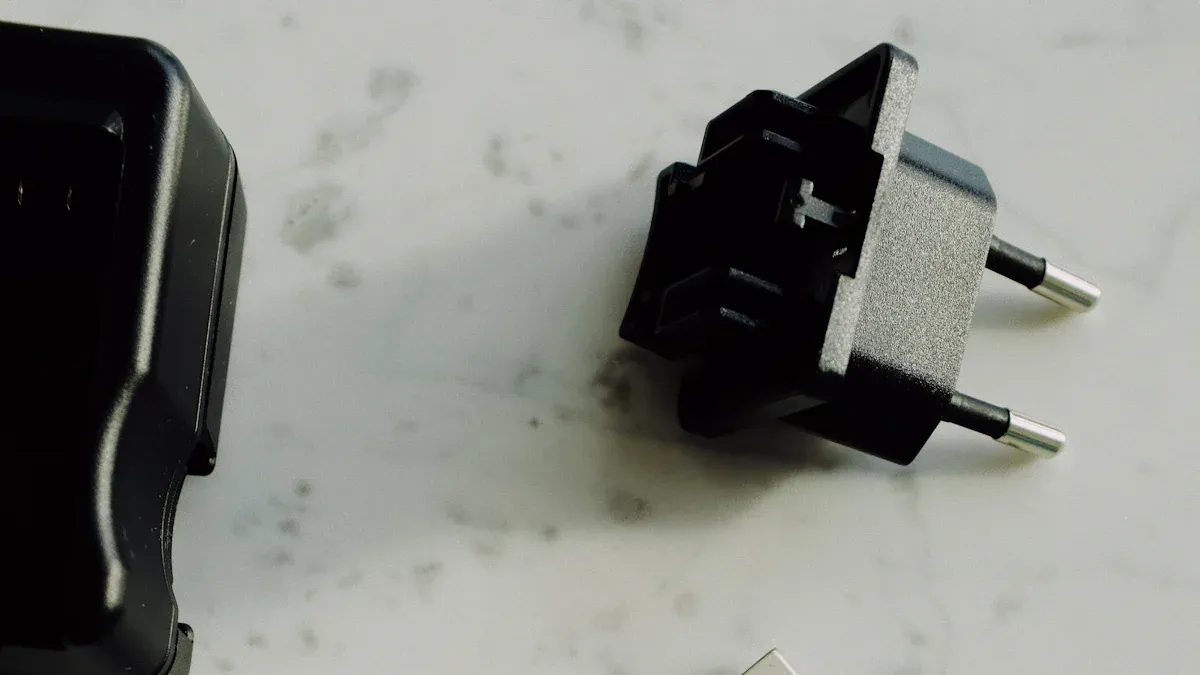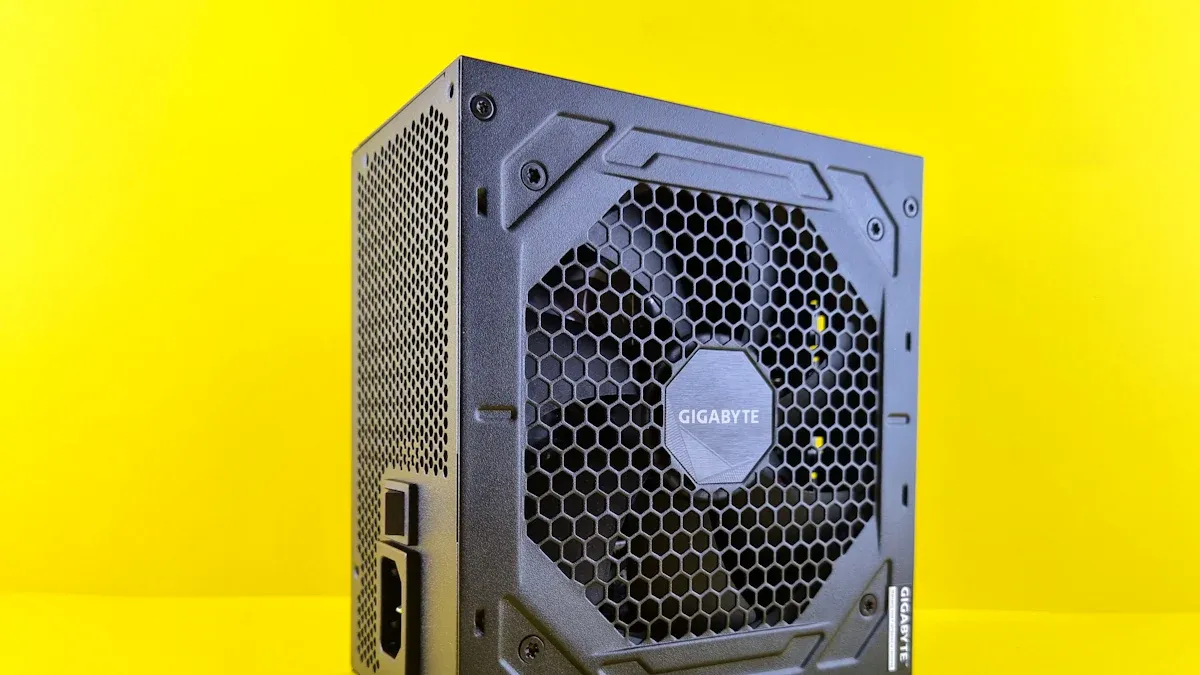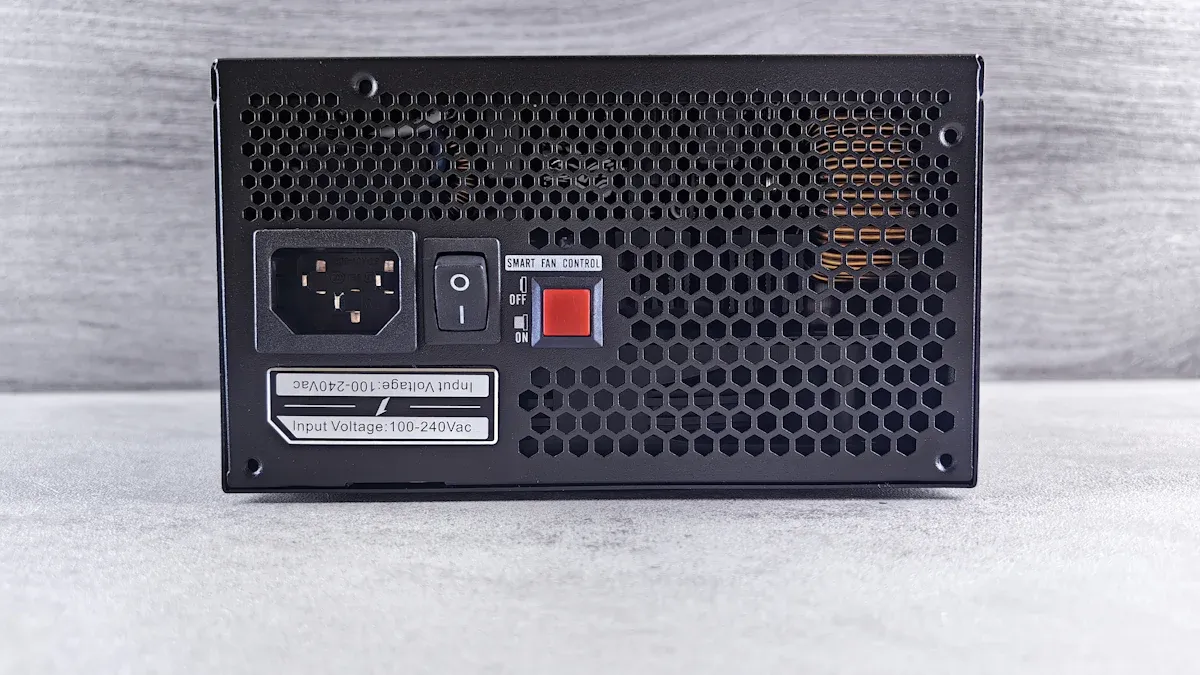What is a Rectifier Module and How Does It Work

A rectifier module changes alternating current (AC) into direct current (DC). It gives steady power to devices that need DC systems. These modules are used in industries needing stable energy. They control voltage and stop problems from changing AC power. New rectifier modules save energy, working up to 98.5% efficiently. This reduces energy waste during conversion. They are important for telecom, factory machines, and green energy systems.
Key Takeaways
Rectifier modules change alternating current (AC) into direct current (DC). This gives steady power to devices needing DC.
New rectifier modules work up to 98.5% efficiently. This lowers energy loss during power conversion.
Picking the right rectifier depends on your power needs. Single-phase rectifiers work for small devices. Three-phase rectifiers are better for big power uses.
Main parts of rectifier modules are diodes, transformers, filters, and heat sinks. These parts help them work better and stay efficient.
Rectifiers are important in many industries like telecommunications, renewable energy, and electronics. They make sure power is steady and reliable.
What Are Rectifier Modules?

Definition and Function
A rectifier module changes alternating current (AC) into direct current (DC). This process, called rectification, helps DC-powered systems work well. These modules are used in many areas, like home gadgets and factory machines. They use diodes to let electricity flow in one direction only.
There are different types of rectifier modules, such as half-wave, full-wave, and bridge rectifiers. Each type is made for specific needs. For instance, half-wave rectifiers are simple but less effective. Full-wave rectifiers give smoother DC power. They can also be single-phase or three-phase, depending on the AC input.
Modern rectifier modules are key for stable and reliable power. They are found in DC power supplies, radio detectors, and green energy systems. Without them, many devices we use daily wouldn’t work properly.
Key Components of a Rectifier Module
Rectifier modules have important parts that help convert power efficiently. These parts include:
Diodes: They let electricity flow one way and block the other.
Transformers: They change the AC voltage to match the DC output.
Filters: They smooth out the DC power, making it steady.
Heat Sinks: They cool down the module to prevent overheating.
Each part improves how the rectifier module works. For example, good diodes make the module more efficient. Filters ensure the DC power is smooth for sensitive devices.
Feature | Description |
|---|---|
Applications | Power for DC Motors, AC/DC Converters, Motor Controllers |
Low Reverse Recovery Loss | Yes |
Low Forward Voltage | Yes |
High Surge Current Capability | Yes |
Low Inductance Package | Yes |
Topology | 2-diode phase leg or common cathode in compact package |
These features show how advanced modern rectifier modules are, meeting many needs.
Importance of AC to DC Conversion
Changing AC to DC is very important for power systems. Most power grids use AC, but many devices need DC to work. Rectifier modules make this possible, ensuring DC devices run smoothly.
In telecom, they provide steady power for 5G networks. In factories, they power machines for automation and digital tools. Electric vehicle chargers also depend on rectifier modules.
The market for rectifier modules may grow from USD 1.5 Billion in 2024 to USD 2.9 Billion by 2033, with a growth rate of 8.1% from 2026 to 2033.
More electrification and better power tech are driving this growth.
Electric cars and energy-saving needs make these modules even more important.
By converting AC to DC well, rectifier modules save energy and improve system performance. They are vital for modern energy solutions, helping create a greener future.
How Rectifier Modules Work
The Rectification Process
The main job of a rectifier module is rectification. It changes alternating current (AC) into direct current (DC). AC flows back and forth, but DC flows in one direction. This change gives devices steady and reliable power.
When AC enters the module, it goes through diodes and filters. Diodes stop current from flowing backward. Filters smooth the power output. This creates a steady DC voltage for devices to use.
How well this works depends on resistance. For example, with a resistance of 0.85 Ω, energy conversion reaches 84%. This is close to the predicted 86%, showing how resistance affects efficiency.
Role of Diodes in Rectifiers
Diodes are key parts of any rectifier module. They let current flow in one direction only. This is needed to turn AC into DC. A rectifier diode blocks the negative part of AC and allows the positive part through.
In a module, diodes are arranged in patterns for different results. A single diode is used in a half-wave rectifier. Multiple diodes in a bridge shape are used for full-wave rectification. These setups decide how smooth and efficient the DC output is.
Without diodes, rectification wouldn’t work. They are vital for giving devices the stable DC power they need.
Single-Phase vs. Three-Phase Rectifiers
Rectifier modules are grouped by the type of AC they handle: single-phase or three-phase. Knowing the difference helps you pick the right one.
Single-Phase Rectifiers:
These work with single-phase AC, like in homes. They are simple and used for low-power things like small gadgets.Three-Phase Rectifiers:
These handle three-phase AC, found in factories. They are more complex but give smoother and more efficient DC. They are great for high-power uses like big machines and green energy systems.
Choose based on your system’s power needs. Single-phase rectifiers are fine for small tasks. Three-phase ones are better for heavy-duty jobs needing high efficiency.
Types of Rectifier Modules

Half-Wave Rectifiers
A half-wave rectifier is the simplest kind of rectifier module. It uses one diode to change alternating current (AC) into direct current (DC). This process allows only half of the AC wave to pass, while the other half is blocked. These rectifiers are used in low-power devices like small appliances or basic power systems.
Half-wave rectifiers are cheap and easy to make. But they have big drawbacks. The output voltage is uneven, and the ripple factor is high. This means the DC output is not steady. They are less efficient than other rectifiers, with efficiency usually below 50%. Even with these issues, their simplicity makes them useful for basic power needs.
Metric | Description |
|---|---|
Ripple Factor | About 1.21, showing large output voltage changes. |
Efficiency (η) | Ratio of DC output power to AC input power. |
Advantages | Simple, low-cost, easy to produce. |
Disadvantages | High ripple, low efficiency, and low output voltage. |
Full-Wave Rectifiers
Full-wave rectifiers are better than half-wave ones. They use both halves of the AC wave, giving smoother and steadier DC output. There are two main types: center-tapped and bridge rectifiers. Both use multiple diodes to perform full-wave rectification.
Full-wave rectifiers are much more efficient than half-wave ones. Their efficiency can reach up to 81.2%. This makes them great for systems needing stable and reliable DC power. They are often used in industries like automation and telecom, where steady power is crucial.
Rectifier Type | Efficiency Comparison | Output Characteristics |
|---|---|---|
Half-wave rectifier | Lower | More ripple, less smooth output |
Center-tapped full-wave rectifier | Higher | Smoother DC output, but more complex design |
Bridge Rectifiers
A bridge rectifier is a type of full-wave rectifier. It uses four diodes in a bridge setup. This design removes the need for a center-tapped transformer, making it cheaper and easier to use. It converts the entire AC wave into DC, giving a steady and smooth output.
Bridge rectifiers are used in high-power systems like industrial machines and renewable energy setups. They are known for being efficient and reliable. Compared to other rectifiers, bridge rectifiers balance cost and performance well. This makes them a popular choice for modern power systems.
Tip: When choosing a rectifier module, think about your needs like power, efficiency, and cost.
Controlled and Uncontrolled Rectifiers
Rectifiers are divided into two types: controlled and uncontrolled. Each type works differently and is used for specific power needs. Knowing their differences helps you pick the right one.
Uncontrolled Rectifiers
Uncontrolled rectifiers use diodes to change AC into DC. Diodes let current flow in one direction automatically, without needing control. These rectifiers are used in simple devices like basic power supplies or small electronics where voltage control isn’t needed.
Uncontrolled rectifiers are cheap and easy to install. But they can’t be adjusted after setup. You can’t change their output voltage or current. This makes them unsuitable for systems needing precise power control.
Controlled Rectifiers
Controlled rectifiers use special parts like thyristors or SCRs instead of diodes. These parts let you decide when the rectifier works. By changing the firing angle, you can control the output voltage and current. This makes controlled rectifiers great for machines or renewable energy systems needing flexible power control.
The Mweene Thesis explains a circuit with both controlled and uncontrolled rectifiers. It says controlled rectifiers can start working later, while diodes handle the current first. Dr. Dickens, an expert, said uncontrolled rectifiers in this setup can’t work at the same time because current paths don’t allow it.
Controlled rectifiers are more efficient and flexible than uncontrolled ones. But they are harder to set up and cost more. They also need regular maintenance.
Choosing the Right Rectifier Module
Think about your system’s needs when picking a rectifier. If you want something simple and cheap, go for an uncontrolled rectifier. If you need precise control or adjustable power, choose a controlled rectifier.
Applications of Rectifier Modules
Industrial Power Systems
Rectifier modules are crucial for powering industrial systems. They convert AC to DC for heavy machines and tools. This ensures a steady power supply, even in tough conditions. Modular rectifiers can grow with needs, fitting many uses. High-frequency rectifiers save space and energy, perfect for tight areas needing efficiency.
Custom rectifiers are made for specific industrial needs. They boost performance and keep power steady. In places with power changes, they prevent disruptions. Studies show rectifiers improve device use and track power health. This lowers downtime and keeps factories and data centers running smoothly.
Feature | Description |
|---|---|
Reliable AC to DC Conversion | Keeps power steady, vital for industrial systems. |
Modular Rectifiers | Flexible solutions for different industrial needs. |
High-Frequency Rectifiers | Small and efficient, great for critical systems. |
Industrial Rectifiers | Built for heavy-duty DC power, reliable in tough settings. |
Custom Rectifier Systems | Designed for specific needs, ensuring top performance. |
Telecom Rectifiers in Telecommunications
Telecom rectifiers power telecom systems like servers and 5G networks. They provide stable DC power for smooth operations. For example, Class 4 rectifiers support 5G, which needs more power than 4G. These rectifiers are very efficient, with up to 96% energy conversion.
Safety is a key feature of telecom rectifiers. They monitor voltage and temperature to avoid failures. This ensures telecom services stay uninterrupted. Advanced rectifiers help maintain reliable networks while saving energy.
Key Features of Telecom Rectifiers:
High efficiency (up to 96%) for better energy use.
Safety systems to prevent problems.
Support for high-power 5G network needs.
Renewable Energy Systems
Renewable energy setups like solar and wind farms depend on rectifiers. These systems make AC into DC for batteries or devices. Rectifiers ensure this process is efficient, reducing energy waste.
Modern rectifiers in renewable energy systems are highly efficient, reaching up to 97.83%. They work best at 277 VAC and stay efficient under full load. This makes them ideal for large renewable projects. Adding rectifiers to these systems improves energy storage and cuts waste.
Metric | Value |
|---|---|
Peak Efficiency | 97.83% |
Voltage for Peak Efficiency | 277 VAC |
Full Load Efficiency (min) | Above target |
Note: Advanced rectifiers in renewable energy systems boost efficiency and support greener energy goals.
Consumer Electronics and Devices
Rectifier modules are important for powering everyday electronics. They change alternating current (AC) from outlets into direct current (DC). DC power is needed for devices like phones, laptops, and gaming consoles. Without rectifiers, these gadgets wouldn’t work properly or last long.
The need for electronics is growing all over the world. This has increased the demand for semiconductor rectifiers. By 2026, this market could reach $6.6 billion, growing at 13.6% yearly. In 2019, consumer electronics made the most money in this market. This shows how vital rectifiers are for daily devices.
Modern rectifiers help devices run smoothly by giving steady DC power. They stop voltage changes that could harm parts in TVs or computers. They also save energy, making batteries last longer in portable devices. This is very useful as people depend more on mobile gadgets for work and fun.
Rectifiers are also key for telecom equipment. They power systems that keep communication networks running. This ensures people stay connected without interruptions. Rectifiers are essential for both personal use and industries needing reliable tech.
When you charge a phone or use a laptop, rectifiers are at work. They provide steady power, making devices efficient and dependable. Rectifiers are a big part of today’s tech-focused world.
Advancements in Rectifier Module Technology
High-Efficiency Rectifier Designs
Modern rectifiers are made to save energy and work better. They are used in systems like renewable energy and factory machines. Engineers use new ideas to improve how rectifiers work. One method, adaptive matching, uses a special capacitor to adjust power flow. This helps transfer energy more efficiently. Another method, self-tuning impedance matching, adjusts itself using feedback from the output voltage.
Design Methodology | Description |
|---|---|
Adaptive Matching | Changes power flow using a special capacitor. |
Self-Tuning Impedance Matching | Adjusts itself using voltage feedback. |
Self-Matching System | Uses special lines to change power flow automatically. |
Wide Dynamic Range Rectifier | Combines FETs and diodes for different power levels. |
These designs make rectifiers more dependable and energy-saving. They are great for systems with changing power needs.
Integration with Smart Power Systems
Rectifiers are now part of smart power systems. These systems manage energy flow intelligently. Rectifiers help keep power steady during changes. For example, in smart grids, they turn AC into DC for energy storage and sharing. They also work well with solar panels, reducing wasted energy.
Smart rectifiers have features like real-time monitoring and problem detection. These features help keep systems running smoothly and avoid downtime. As smart systems grow, rectifiers will be even more important for clean energy solutions.
Trends in Miniaturization and Durability
Smaller and tougher rectifiers are becoming more popular. You can see this in electronics, where devices are tiny but powerful. Engineers now make rectifiers with small parts that fit tight spaces. High-frequency rectifiers use advanced materials to stay small and efficient.
Durability is also a focus. Modern rectifiers are built to handle tough conditions. They use heat-resistant materials and strong designs to last longer. These trends make rectifiers more useful and reliable for many applications.
Rectifier modules are important for changing AC to DC power. They give steady energy to devices in many industries. You can find them in telecom, green energy, and factory systems. They stop voltage spikes and power surges, protecting equipment and making it last longer.
Main features include:
Better efficiency with active power factor correction.
Smart systems to avoid power problems.
Flexible designs for different uses.
New ideas use materials like wide-bandgap semiconductors. These improve performance and save energy. Smaller designs with more power are now common. They are easier to use and cost less. As technology grows, rectifier modules will help create greener and smarter energy systems.
FAQ
What does a rectifier module do?
A rectifier module changes alternating current (AC) into direct current (DC). This process gives steady power to devices needing DC. It is important for electronics, factories, and renewable energy systems.
How can you pick the right rectifier module?
Think about your system's power needs. For simple tasks, use an uncontrolled rectifier. For precise or adjustable power, pick a controlled rectifier. Check its efficiency, voltage range, and if it fits your devices.
Do rectifier modules help save energy?
Yes, modern rectifiers are very efficient. Some can convert up to 98% of energy, wasting less. They are great for saving energy in green systems and factory machines.
Are rectifier modules used in green energy systems?
Yes! Rectifier modules are key in solar and wind systems. They turn AC from generators into DC for storage or use. High-efficiency rectifiers cut energy loss, helping green energy work better.
How are single-phase and three-phase rectifiers different?
Single-phase rectifiers are for small power needs, like home devices. Three-phase rectifiers handle more power and give smoother DC. They are best for factories and big energy systems.
Tip: Always choose the rectifier that matches your power needs for the best results.
See Also
Integrating Solar Inverters and Batteries for Telecom Power Solutions
Calculating Power Systems and Battery Needs for Telecom Cabinets
Ensuring Consistent Power Supply for Telecom Cabinet Operations
CALL US DIRECTLY
86-13752765943
3A-8, SHUIWAN 1979 SQUARE (PHASE II), NO.111, TAIZI ROAD,SHUIWAN COMMUNITY, ZHAOSHANG STREET, NANSHAN DISTRICT, SHENZHEN, GUANGDONG, CHINA

